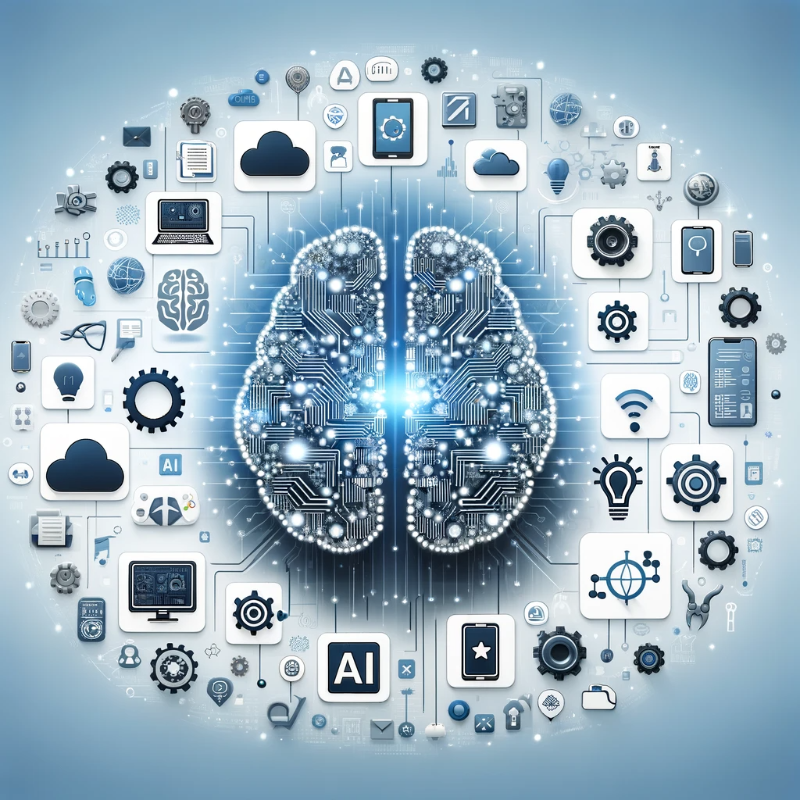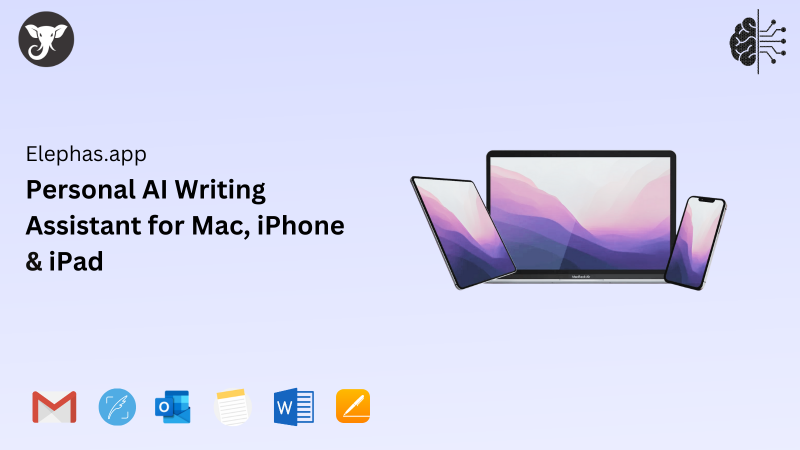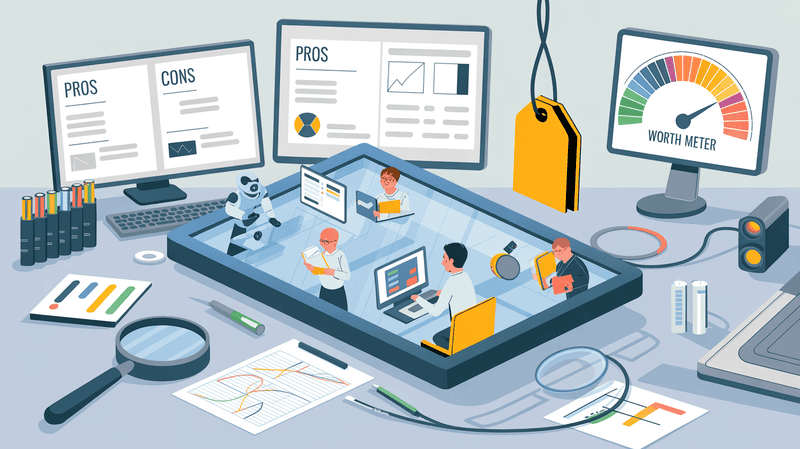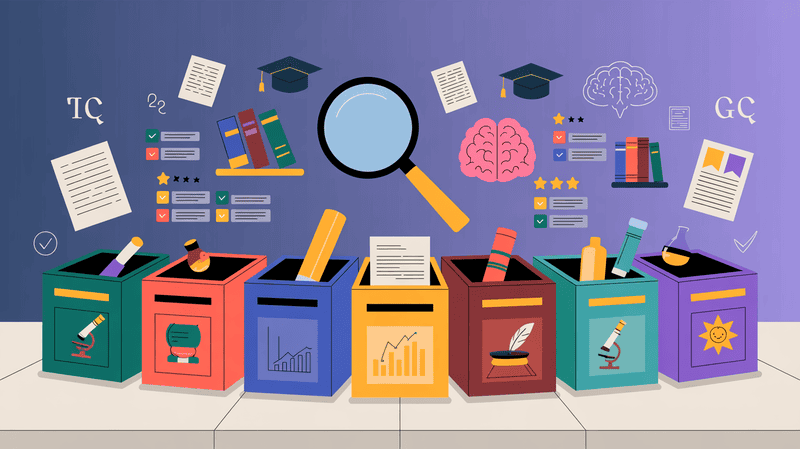Have you ever thought about maximising your potential, increasing your productivity, and living a more profitable life?
The solution is to develop your second brain.
Tiago Forte's idea of the Second Brain offers a game-changing solution in a world flooded with continual information.
Can you remember every important detail during the everyday chaos?
Most likely not. But you could.
Enter the stage of our in-depth guide: 13 Steps to Building a Second Brain With AI (In 2025)! Discover tools, apps, and resources that transform information management and ensure nothing falls between the gaps.
Are you ready to change your life? So, Keep reading.
Contents
- What is the Second Brain?
- Role of AI in Building a Second Brain
- 1- Information Processing and Organization
- 2- Data Retrieval and Search
- 3- Personalized Recommendations
- 4- Collaboration and Communication
- 5- Adaptive Learning
- 6- Security and Privacy
- What are the Benefits of Having a Second Brain?
- Enhanced Memory and Organization
- Increased Productivity
- Creative Stimulus
- Seamless Collaboration
- Continuous Learning and Growth
- Step 1 - Define Your Goals
- A- Setting Clear Objectives for Building a Second Brain
- B- Identifying Your Specific Needs and Priorities
- Step 2 - Choose the Right AI Tools
- A- Overview of AI Tools for Building a Second Brain
- B- Comparing Different AI Options Available in 2024
- Step 3: Implementing a Knowledge Management System
- A- Organizing and Storing Information Efficiently
- B- Using AI for Categorizing and Storing Information Efficiently
- Step 4: Automating Information Retrieval
- A- Leveraging AI for Quick Access to Relevant Information
- B. Integrating AI-powered Search and Recommendation Systems
- Step 5: Using AI for Content Creation
- A- Generating and Curating Content With AI Assistance
- B- Incorporating AI Writing Tools for Note-taking and Idea Generation
- Step 6: Personalizing Your Second Brain
- A- Tailoring Your Second Brain to Fit Your Individual Preferences
- B- Customizing AI Algorithms to Better Serve Your Needs
- Step 7: Connecting Your Second Brain to Other Apps
- A- Integrating AI Powered Features With Existing Apps and Platforms
- B- Creating a Seamless Workflow Between Your Second Brain and Other Apps
- Step 8: Implementing AI for Task Management
- Step 9: Leveraging AI for Decision-Making
- A- Utilizing AI to Analyze Data and Make Informed Decisions
- B- Incorporating AI Algorithms for Predictive Modeling and Trend Analysis
- Step 10- Securing Your Second Brain
- A- Protecting Sensitive Information With AI-driven Security Measures
- B- Ensuring Data Privacy and Confidentiality Through AI Technologies
- Step 11- Maintaining and Updating Your Second Brain
- A- Establishing a Routine for Managing and Updating Your Second Brain
- B- Leveraging AI for Automated Maintenance and Data Cleansing
- Step 12- Measuring the Impact of Your Brain
- A- Evaluating the Effectiveness of Your Second Brain
- B- Using AI Analytics to Track and Measure Productivity Gains
- Step 13- Seeking Continous Improvement
- A- Embracing a Growth Mindset for Ongoing Enhancement of Your Second Brain
- B- Exploring New AI Tools and Resources for Future Optimization
- Final Thoughts!
What is the Second Brain?
A "second brain" is a means of digitally organising and managing your thoughts, ideas, notes, suggestions, queries, and nearly any other material you want to remember. It functions as a comprehensive system for encapsulating and storing all of these disparate pieces of information, making them readily available to your future self.
This method lets you quickly retrieve insights, recollect previous thoughts, and save essential information that would otherwise be lost.
A second brain serves as a digital extension of your cognitive capabilities, ensuring that important details are easily retrievable when needed, capturing fleeting thoughts, documenting ancestral recipes passed down by your mother, or simply recording concepts you didn't have a chance to write down immediately.

Role of AI in Building a Second Brain
1- Information Processing and Organization
Artificial intelligence is critical in efficiently processing and organising massive volumes of data. AI assists in categorising and structuring data through complex algorithms, providing smooth access to pertinent information for users attempting to develop their second brain.
2- Data Retrieval and Search
AI advances the concept of the second brain by providing robust data retrieval and search capabilities. Machine learning algorithms allow for the quick and accurate identification of critical data, guaranteeing that users may easily search and retrieve information required for cognitive augmentation.
3- Personalized Recommendations
AI-powered systems excel at providing personalised recommendations and customising material depending on user preferences and behaviour. This function is essential to the second brain because it guarantees that individuals receive content relevant to their interests, thereby speeding up the process of knowledge absorption and retention.
4- Collaboration and Communication
Artificial Intelligence fosters collaboration within the second brain framework by enabling efficient communication and information sharing. Intelligent algorithms facilitate seamless collaboration among users, promoting the exchange of ideas, insights, and knowledge to enhance collective intelligence.
5- Adaptive Learning
Within the second brain framework, AI significantly contributes to adaptive learning. AI systems can modify and refine content recommendations over time by studying user interactions and learning patterns, enhancing the learning experience and building a more personalised and effective second brain.
6- Security and Privacy
AI is essential in safeguarding the second brain ecosystem's security and privacy. AI-powered advanced encryption, authentication, and anomaly detection processes protect sensitive information, providing users with a secure environment for storing and managing their digital knowledge store.
What are the Benefits of Having a Second Brain?
Enhanced Memory and Organization
A second brain, frequently in the form of digital note-taking or knowledge management systems, aids in information organisation and storage. This improves memory by supplying a dependable external storage device. Users may quickly access and examine information, promoting a more structured and efficient thought process.
Increased Productivity
A second brain aids in work management and prioritisation, increasing productivity. Individuals can optimise their workflow by centralising ideas, to-do lists, and project information. This saves time and clears the mind, allowing for more concentrated and practical work.
Creative Stimulus
A second brain fosters creativity by acting as a repository for ideas, inspirations, and insights. It provides a dedicated location for concept generation and refinement, boosting innovation. Individuals can make connections and produce creative ideas more quickly when they have ready access to a varied range of thinking.
Seamless Collaboration
With a second brain, collaboration becomes simple because shared platforms allow team members to contribute, modify, and access information collectively. This encourages effective knowledge sharing, reduces misinterpretation, and improves teamwork. Shared resources help to build collective intelligence, which fuels collaborative achievement.
Continuous Learning and Growth
A second brain facilitates ongoing learning by storing knowledge acquired over time. Users can create a personalised knowledge base by archiving articles, thoughts, and lessons. This continuous learning process promotes skill development, fosters curiosity, and leads to long-term personal and professional development.
Step 1 - Define Your Goals
A- Setting Clear Objectives for Building a Second Brain
When building a second brain, it's essential to define clear objectives.
Ask yourself: What do you want to achieve? Why do you want a second brain?
Whether it's enhancing productivity, fostering creativity, or streamlining information management, articulate your goals.
These objectives will serve as guiding lights, shaping your approach to implementing AI in creating a second brain.
By crystallising your goals, you gain a sense of purpose and lay the foundation for a tailored and effective second-brain strategy.
B- Identifying Your Specific Needs and Priorities
Every individual's needs and priorities differ when building a second brain.
Identify the areas in your life, work, or learning that require optimisation.
Pinpointing these needs allows you to tailor your second brain to address your unique challenges.
By understanding your priorities, you can strategically leverage AI tools and resources to create a second brain that aligns seamlessly with your lifestyle.
This ensures a more personalised and impactful technology integration into your daily routine.
Step 2 - Choose the Right AI Tools
A- Overview of AI Tools for Building a Second Brain

When building your second brain, choosing the right AI tools is crucial.
One notable tool worth mentioning is the Elephas app, a versatile platform seamlessly integrating with various second-brain tools. Elephas simplifies organising and accessing information across your chosen platforms, making it a valuable asset in enhancing cognitive workflow.
By integrating with popular second brain tools, Elephas ensures a smooth and unified experience, empowering you to maximise digital brain augmentation.
Elephas is not a note taking tool, but it works with all powerful note taking tools that you can use for your second brain.
You
may even have your second brain set up in multiple note taking apps,
you can consolidate them by create super brains inside Elephas.
Checkout this guide for more details -
If you're a Mac user, then Elephas is your best bet at building an AI powered second brain that actually works!
B- Comparing Different AI Options Available in 2025
In 2025, an extensive range of AI-powered tools can help in second-brain development.
Note-taking enthusiasts can explore options like Obsidian, Notion, Taskad AI, Bear App, Roam Research, and Evernote.
- Obsidian excels in fostering interconnected thoughts.
- Notion provides a collaborative platform.
- Taskad AI streamlines task management with its intelligent features.
- Bear App offers simplicity in note-taking.
- Roam Research emphasises fluid note connections.
- Evernote remains a reliable classic.
You can explore these tools based on your unique needs to find the
perfect fit for constructing your second brain effortlessly in 2025.
For a detailed look at more second brain apps, check out this guide -
Step 3: Implementing a Knowledge Management System
A- Organizing and Storing Information Efficiently
Organising and storing information efficiently is critical to building a second brain with AI. This involves creating a structured system for your data.
Start by categorising information into folders or tags based on topics or relevance.
Utilise clear naming conventions to quickly identify and retrieve data when needed. Using a logical and consistent organisation strategy enhances accessibility and reduces the time spent searching for specific information.
Whether using cloud storage solutions or local databases, prioritise simplicity and clarity in your organisational approach to create a foundation for a robust second brain.
B- Using AI for Categorizing and Storing Information Efficiently
Use AI to boost your information management.
AI categorisation solutions automatically analyse and organise data, improving the organisational process.
Implement smart tagging and labelling systems that use machine learning to interpret content contextually.
This improves efficiency and adds to a more intuitive and adaptive system over time. Investigate AI-powered storage solutions that adapt to your usage patterns, enabling smooth interaction with your evolving second brain. With these powerful AI technologies, embrace the future of information management.
If you use a Elephas to manage your second brain, then you don't need to worry about categorization, you can just create a super brain for every topic or project that you care about, and dump all your notes and files into it.
And you can start retrieving information about the topic from the super brain that you created inside Elephas.
For more details check out this detailed walk through -
Step 4: Automating Information Retrieval
A- Leveraging AI for Quick Access to Relevant Information
We focus on quick and effective knowledge retrieval in Step 4 of developing your second brain with AI.
You can improve your productivity and save time by embracing Artificial Intelligence (AI). AI-powered technologies evaluate your data, learn about your preferences, and provide immediate access to relevant information.
This means no more tedious searches or rummaging through files. With advanced algorithms, your second brain transforms into a powerhouse for quick, precise information retrieval, allowing you to focus on what matters most.
B. Integrating AI-powered Search and Recommendation Systems
To supercharge your second brain, integrate AI-powered search and recommendation systems.
These tools go beyond basic search functionalities, understanding your context and preferences to deliver personalised suggestions. Whether recommending relevant articles, suggesting connections between ideas, or predicting your following query, AI transforms your information management.
By seamlessly integrating these systems into your workflow, you'll experience a smoother, more intuitive second brain.
Step 5: Using AI for Content Creation
A- Generating and Curating Content With AI Assistance
AI tools can swiftly generate relevant content and curate information from diverse sources. They streamline the research process, providing a solid foundation for articles, blog posts, or social media updates.
With AI, you can efficiently sift through vast amounts of data, ensuring your content is not only informative but also up-to-date.
Whether it's creating engaging narratives or summarizing complex topics, AI becomes your trusted assistant in content generation, helping you produce high-quality material without the usual time-consuming efforts.
B- Incorporating AI Writing Tools for Note-taking and Idea Generation
Incorporating AI writing tools into your note-taking and idea-generation process elevates efficiency and creativity.
These tools, equipped with advanced natural language processing capabilities, assist in brainstorming ideas and structuring notes. By leveraging AI, you can quickly transform scattered thoughts into organized, coherent content.
These writing tools not only enhance productivity but also provide intelligent suggestions for word choices and sentence construction. Whether you're jotting down ideas for a project or taking meeting notes.
Step 6: Personalizing Your Second Brain
A- Tailoring Your Second Brain to Fit Your Individual Preferences
Now that you've laid the foundation for your second brain, it's time to make it uniquely yours. Personalize your digital workspace by organizing folders, tags, and categories in a way that resonates with your thinking.
Tailor note-taking styles to match your preferences, whether it's bullet points, mind maps, or plain text. This step is about creating an environment that feels intuitive and aligns with your workflow.
The more personalized your second brain is, the more seamlessly it integrates into your daily life, becoming a reliable extension of your mind.
B- Customizing AI Algorithms to Better Serve Your Needs
Utilize the power of AI to improve your second brain experience. Create your own algorithms to prioritize and surface information pertinent to your goals and interests.
You need to modify the systems to meet your individual needs, whether it's improving search results, automating processes, or finding links between ideas.
This personalization guarantees that your AI assistant becomes a useful ally, saving you time and effort by delivering exactly what you need.
Step 7: Connecting Your Second Brain to Other Apps
A- Integrating AI Powered Features With Existing Apps and Platforms
Integrate the power of AI into your second brain by utilizing existing tools such as Logseq, Workflowy, Elephas, Milanote, and Mem AI.
These tools put artificial intelligence capabilities at your fingertips, improving organization, content development, and data analysis.
- Structured thinking is facilitated by Elephas, Logseq and Workflowy.
- Visual organizing is streamlined by Milanote.
- Mem AI provides intelligent data retrieval to your second brain, making information readily available for your tasks.
Integrate these AI-powered technologies to boost the functionality of your second brain.
B- Creating a Seamless Workflow Between Your Second Brain and Other Apps
Ensure a smooth and efficient workflow by integrating your second brain with popular apps like Microsoft OneNote, Reflect Notes, Google Keep, and Apple Notes. Bridge the gap between your second brain and these widely-used platforms to maximize accessibility and collaboration. Microsoft OneNote offers robust note-taking capabilities, while Reflect Notes focuses on mindful organization. Google Keep simplifies capturing thoughts on the go, and Apple Notes seamlessly integrates with Apple devices.
Step 8: Implementing AI for Task Management
A- Using AI to Prioritize and Organize Tasks
Prioritizing and arranging work becomes second nature in the attempt to create a second brain using AI. Artificial intelligence evaluates task data, taking deadlines, importance, and dependencies into account.
It then recommends a smart arrangement for completing things efficiently. This guarantees that critical chores are completed first, avoiding overburden.
With AI-driven prioritizing, your second brain transforms into an intelligent assistant, assisting you in seamlessly navigating the complexity of your workload.
B- Automating Task Assignments and Reminders
By assigning duties and giving regular reminders, automation relieves you of the load.
AI algorithms study your work routines, figuring out when and how you want to be reminded.
Task assignments become more smooth, allowing you to concentrate on production while your second brain ensures that nothing falls through the cracks.
This level of automation not only saves time but also decreases the possibility of overlooking crucial duties.
Step 9: Leveraging AI for Decision-Making
A- Utilizing AI to Analyze Data and Make Informed Decisions
Using AI to analyze data and enable informed decision-making is a vital step in the quest to construct your second brain.
You may simply sift through enormous datasets using AI technology, collecting crucial insights that would otherwise be ignored. This method not only saves time but also increases the accuracy of your choices.
By leveraging AI-driven analytics, you enable your second brain to efficiently absorb information, ensuring that you stay informed and make sound decisions in both personal and professional settings.
B- Incorporating AI Algorithms for Predictive Modeling and Trend Analysis
Take your second brain to the next level by incorporating AI algorithms for predictive modelling and trend analysis.
This strategic approach allows you to forecast future developments based on historical data trends.
AI algorithms excel at extrapolating insights, whether they are forecasting market trends, predicting user behaviour, or identifying emerging patterns in your personal interests.
By combining these predictive qualities into your second brain, you provide yourself with a forward-thinking tool.
Step 10- Securing Your Second Brain
A- Protecting Sensitive Information With AI-driven Security Measures
Take your second brain to the next level by incorporating AI algorithms for predictive modelling and trend analysis. This strategic approach allows you to forecast future developments based on historical data trends.
AI algorithms excel at extrapolating insights, whether they are forecasting market trends, predicting user behaviour, or identifying emerging patterns in your personal interests.
By combining these predictive qualities into your second brain, you provide yourself with a forward-thinking tool that not only understands the present but also aids in planning for what lies ahead.
B- Ensuring Data Privacy and Confidentiality Through AI Technologies
When building your second brain, prioritize data privacy and confidentiality with AI technologies.
These tools go beyond traditional methods, actively monitoring and controlling access to sensitive data.
By deploying advanced algorithms, AI ensures that only authorized users can access and manipulate your stored information.
This proactive approach helps you maintain control over your digital space, mitigating the risk of data breaches and unauthorized disclosures.
Step 11- Maintaining and Updating Your Second Brain
A- Establishing a Routine for Managing and Updating Your Second Brain
To ensure your second brain stays organized and relevant, establish a routine for regular maintenance. Dedicate specific times each week to review and update your stored information.
Delete outdated data, add new insights, and organize files systematically.
Consistent upkeep ensures your second brain remains a reliable resource, helping you effortlessly retrieve valuable information when needed.
B- Leveraging AI for Automated Maintenance and Data Cleansing
AI systems that automate processes like data cleansing and categorization might help you simplify maintenance.
Use AI algorithms to successfully find and delete duplicates, update timestamps, and categorize information.
By incorporating AI into your second brain workflow, you can expedite maintenance, save time, and ensure your system remains efficient and clutter-free.
Embrace the power of automation to keep your second brain in great form effortlessly.
Step 12- Measuring the Impact of Your Brain
A- Evaluating the Effectiveness of Your Second Brain
Now that your second brain is up and running, it's essential to assess its effectiveness.
Take a closer look at how well it helps you organize information, retrieve data, and enhance your overall productivity.
Track the time saved and the reduction in mental load. Ask yourself: Are you finding information faster? Are tasks more streamlined?
By evaluating these aspects, you can determine the real-world impact of your second brain and make any necessary adjustments to optimize its functionality for your unique needs.
B- Using AI Analytics to Track and Measure Productivity Gains
Make use of AI analytics to measure the benefits of your second brain.
Investigate tools that offer useful measurements of task completion times, information retrieval rates, and general productivity trends. You can find patterns and areas for improvement by employing data-driven insights.
Analyze the quantifiable findings over time to see how your second brain affects your everyday routine. This method enables you to make informed judgments.
Step 13- Seeking Continous Improvement
A- Embracing a Growth Mindset for Ongoing Enhancement of Your Second Brain
Adopting a growth mentality is critical while developing your second brain with AI. Maintain an open mind when it comes to learning, adjusting, and refining your approach.
Accept obstacles as opportunities to learn and improve. Consider setbacks to be stepping stones toward success rather than failures.
This perspective feeds your desire to constantly polish and improve your second brain, maintaining its relevance and efficiency throughout time.
B- Exploring New AI Tools and Resources for Future Optimization
The AI landscape is always changing, creating intriguing opportunities for your second brain.
To keep ahead of the curve, investigate new tools and resources on a regular basis.
Keep a look out for new technologies and breakthroughs that could improve the capabilities of your second brain.
Whether it's new apps, updated algorithms, or better integration methods, embracing the most recent AI breakthroughs ensures that your second brain stays a valuable ally in organizing and handling information.
Final Thoughts!
We conclude that building a second brain with AI is now simpler than ever. The 13 steps outlined provide a practical roadmap using accessible tools and apps in 2025.
From note-taking to task management, these methods empower you to organize and enhance your digital life.
By embracing AI, you can efficiently store, retrieve, and leverage information.
Remember, start small, stay consistent, and customize these steps to fit your needs. This guide equips you with the basics to harness the power of AI in structuring your thoughts and optimizing productivity.


